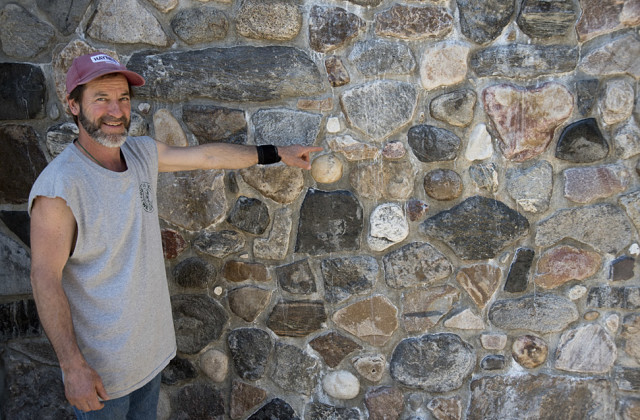From Riverbed to Lasting Art
Jim Kochiss leaves no stone unturned
By Colleen Gundlach
Most people step over rocks, whether in the river or on the roadside, without a second thought, but not Jim Kochiss. This lifetime Norfolk resident sees the potential for beauty in each stone, and has the ability to bring out the true personality of every rock he finds.
Driving into his yard, visitors are first struck by the huge retaining wall, built meticulously by hand, stone-by-stone, over the course of two years. Each rock was carefully chosen from 14 pallets of stone taken from river beds and fields all over Norfolk. Intricately designed and fit together like a puzzle, the wall is a work of art—a testament to Kochiss’ artistic ability, and his masonry talents.
In looking at the wall as a whole, attention is drawn to a rose hued, heart-shaped rock that gleams at eye-level. This particular artifact was carefully placed in honor of the mason’s father, Ed Kochiss. “My dad was a talented mason who taught his kids to build stone walls,” says Kochiss. He credits his father with starting him on his pursuit of rocks as well as encouraging him in his career as a concrete and stone mason.
To say that Jim Kochiss is a rock collector would be a huge understatement. The rocks in the retaining wall are only the tip of the iceberg, so to speak. In his living room, the mason’s favorite perfectly smooth, highly polished river rocks are creatively displayed on individual, staggered shelves, reflecting the sun coming through the large windows overlooking the Blackberry River, from which many of the stones came.

Jim Kochiss has a display case in his living room for some of his favorite rocks.
A large tray of smooth, round stones is also on display, but a hollow coffee table with a glass top that used to be a showcase for some favorite pieces (crafted by Bill Whalen) is temporarily missing from the room. “We put it away for a while,” says Kochiss. “My wife and I decided that glass, rocks and our three-year-old son are not a good combination.”
In his workshop, Kochiss has some newly found rocks that are in the process of being polished. He applies a rock sealer to the specimens, which highlights the inherent colors in the stones and gives them a highly polished glow.
Kochiss doesn’t polish all of his collection, though. In the yard are gardens of rocks of all shapes, sizes and colors. Some line the flower beds near the house and some stand, sculpture-like, around the property. One 200-pound, heart-shaped, local granite specimen came from the old Curtiss Farm in Norfolk and is naturally formed, having never been touched by a chisel. It stands guard near two hollowed-out rocks that serve as a dog-watering dish and a bird bath, respectively. Both were created by John Bascetta.
Small, perfectly round rocks are the hardest to find, according to Kochiss, but are among his favorites. “These rocks have most likely been in the river, rolling over and over for many years,” he says. “They are made into perfectly round jewels.” He also points out some orange granite specimens and others that are actually individual rocks imbedded inside other rocks as the result of years of friction and pressure.
From rocks that look like crystals to stones with holes like Swiss cheese that were ingrained by gas bubbles, Kochiss has them all, and is always on the lookout for another perfect specimen or just a beautiful piece. “There’s no such thing as a bad stone,” he says. “Just one that hasn’t been laid in the right spot yet.”
Photos by Bruce Frisch.

